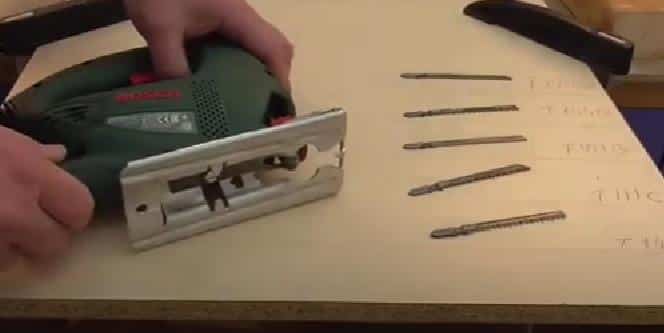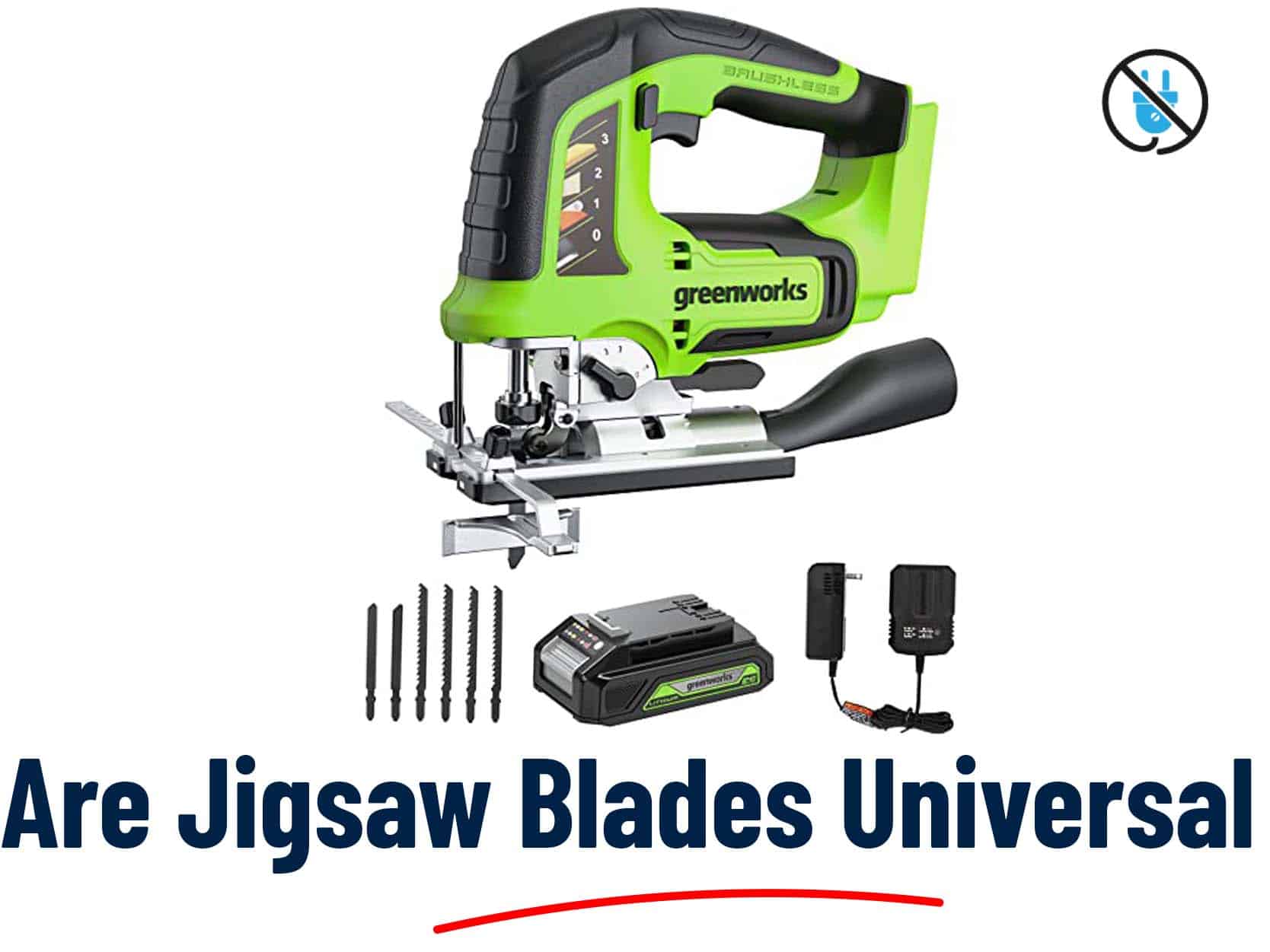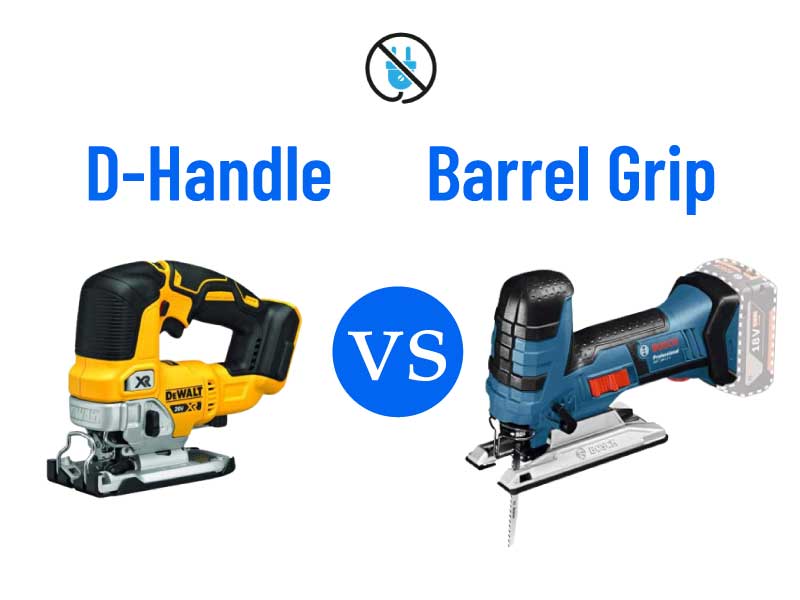No, jigsaw blades are not universal.
Do you like to do DIY projects and want to improve your cutting skills? Jigsaws are powerful and versatile tools that can easily cut through various materials.
But if you’ve never used a jigsaw before, you might not know what kind of blade to use. Are jigsaw blades universal? When they first start using jigsaws, many people ask this question.
Jigsaw blades are not universal, but a few types will fit most jigsaw makes and models. The most common type is the T-shank blade, with a T-shaped shank that fits into the jigsaw’s chuck.
Another common type is the U-shank blade, which has a U-shaped shank that fits into the jigsaw’s chuck. There are a few other, less common blades, but the T- and U-shank blades are the most popular.
In this article, we’ll look at jigsaw blades more closely and determine whether they’re universal or not.
Are Jigsaw Blades Universal?
No, jigsaw blades are not universal.

Jigsaw blades are an essential component of a jigsaw power tool. They are used for cutting through a wide range of materials such as wood, metal, plastics, and ceramics. However, the question that many people often ask is whether jigsaw blades are universal. The answer is no, jigsaw blades are not universal.
Yet, most jigsaw blades will fit most jigsaw makes and models, but there are always exceptions. Knowing which type of blade you need for your particular jigsaw is important. Now, I’ll go over the different types of jigsaw blades and how to determine which one you need.
There are three main types of jigsaw blades: T-shank, U-shank, and bayonet. T-shank blades are the most common and will fit most jigsaw makes and models. U-shank blades are less common and are specific to certain models. Bayonet blades are even less common and are specific to even fewer models.
To determine which type of blade you need, start by finding the model number of your jigsaw. Once you have the model number, you can reference a blade compatibility chart or contact the manufacturer to find out which type of blade you need.
Now that you know which blade you need, let’s review how to install it. Most jigsaws have a blade-release lever or button that you’ll need to press to insert the blade. Insert the blade into the blade holder with the teeth facing in the correct direction. Consult your jigsaw’s manual if you’re unsure how the teeth should face. Once the blade is inserted, release the lever or button to lock it.
Now you’re ready to get started on your project. When you’re finished, unplug your jigsaw and release the blade before removing it.
Let’s say you’re working on a project requiring many curves. You’ll want to use a blade with small teeth in this case. The fewer teeth a blade has, the more aggressive the cut will be. This is good for quickly cutting through material but can also create a rougher edge. If you need a smoother edge, choose a blade with more teeth.
Now that you know all about jigsaw blades, you’re ready to tackle any project that comes your way.
Jigsaw Blade Overview
Jigsaws are versatile power tools that allow you to make intricate cuts in various materials, including wood, plastic, and metal. The key to getting the most out of your jigsaw is to use the right blade for the job.
What Are Jigsaw Blades?
Jigsaw blades are cutting tools that fit into the blade holder of a jigsaw. They are usually long, thin, and narrow; one edge has teeth that cut through things as the blade moves up and down. Jigsaw blades come in different materials, tooth shapes, and sizes; each is made for a different cutting job.
Different kinds of jigsaw blades

There are many kinds of jigsaw blades, each made for a different kind of material and task. Some of the most common types of jigsaw blades are listed below:
- High-carbon steel blades: Blades made of high-carbon steel are the least expensive and can be used to cut softwoods and plastics.
- Bi-metal blades: The cutting edge of these blades is made of high-speed steel, and the back is made of a flexible alloy steel. They last longer than high-carbon steel blades and can cut through a wider range of materials, including non-ferrous metals and hardwoods.
- Tungsten carbide grit blades: Blades with a tungsten carbide grit coating can cut through tough materials like ceramics and fiberglass.
- Diamond grit blades: Diamond-grit blades can cut through very hard materials like tile and stone because they are coated with diamond grit.
- Scroll blades: These blades have small teeth that let them cut curved shapes with great detail.
What Is The Difference Between A Jigsaw Blade And A Standard Blade?
Jigsaw blades are designed to cut curves, while standard blades are designed to cut straight lines.
One of the most common questions is, “What is the difference between a jigsaw blade and a standard blade?” To help answer this question, we’ve compiled a quick guide outlining the main differences between the blades.
Jigsaw blades are designed for cutting curves and intricate shapes in wood, metal, and plastic. They have a smaller, more maneuverable blade than a standard blade, and the teeth on a jigsaw blade are also more closely spaced. This makes them ideal for making tight, clean cuts in materials that would be difficult to cut with a standard blade.
On the other hand, standard blades are designed for making straight cuts in wood, metal, and plastic. They have a larger, more powerful blade than a jigsaw blade, and the teeth on a standard blade are more widely spaced. This makes them ideal for making quick, rough cuts in materials that would be difficult to cut with a jigsaw blade.
So, which type of blade should you use for your next project? A jigsaw blade is the way to go if you want to make intricate, detailed cuts. However, a standard blade will do the trick if you want to make quick, rough cuts.
Can I Use A Jigsaw Blade To Cut Through Metal?
No, you cannot use a jigsaw blade to cut through metal.
If you want to cut through metal, you might wonder if a jigsaw blade will do the trick. The answer is: it depends.
Jigsaw blades are made of high-carbon steel or bimetal and are designed for cutting wood and soft metals like aluminum. But with the right blade, a jigsaw can cut through tougher metals like stainless steel and cast iron.
Here’s a step-by-step guide to cutting through metal with a jigsaw:
- Choose the right blade: For thicker metals, like stainless steel or cast iron, you’ll need a blade with more teeth per inch (TPI). A blade with 14 or 18 TPI will work well for most applications.
- Set your jigsaw to the correct speed: When cutting through metal, it’s important to use a slower speed than you would for wood. This will help prevent the blade from overheating and breaking.
- Mark your cut line: Use a permanent marker or chalk to mark your cutting line. This will help you stay on track.
- Start cutting: Place the blade on the metal and start the jigsaw. Keep the blade perpendicular to the metal as you follow your cut line.
- Use support: If the metal you’re cutting is too thick to hold comfortably, use a piece of scrap wood or another object to support it.
- Finish cutting: Once you’ve reached the end of your cut line, stop the jigsaw and remove the blade.
Cutting through metal with a jigsaw is possible with the right blade and a little patience. Just be sure to follow the steps above and take your time.
Does a Jigsaw need different blades for different materials?
Yes, you need to use different blades for different types of materials.
If you’ve ever tackled a jigsaw puzzle, you know that different pieces form the big picture. The same applies when you use a jigsaw to cut wood, metal, or plastic. Each type of material requires a different blade to get the best results.
You’ll need a blade with fine teeth for wood to avoid splintering. For metal, a blade with coarser teeth is better. And for plastic, you’ll want a blade specifically designed for cutting that material.
Let’s say you’re working on a wood and metal cutting project. In that case, you’ll need two different blades for your jigsaw. You can find blades designed for specific materials or a multi-purpose blade that can be used for different materials.
You can find it at your local home improvement store, no matter what blade you need. And if you’re not sure which blade to use for a particular material, the store staff can usually give you some helpful advice.
How to Select the Right Jigsaw Blade

Choosing the right jigsaw blade is important if you want a clean cut. Here are some tips on how to choose the right blade for a jigsaw:
- Think about what you’ll be cutting: Different materials need different blades. For instance, if you want to cut metal, you’ll need a blade made for cutting metal.
- Think about how thick the material is: The thicker the material, the more teeth per inch (TPI) your blade will need. For example, cutting a thick piece of wood will require a lower TPI blade to avoid getting too hot.
- Choose the right blade shape: Different blades are made for different kinds of cutting. For instance, a straight blade is best for making straight cuts, while a curved blade is best for making curved cuts.
What Is The Best Way To Clean A Jigsaw Blade?
To clean a jigsaw blade, wipe it down with a rag.
If you use a jigsaw, you know that the blade can become dull and clogged with sawdust over time. Not only is this frustrating, but it can also make your cuts less precise. So, what is the best way to clean a jigsaw blade?
Here are some simple steps to follow:
- First, unplug the jigsaw and remove the blade.
- Use a brush or compressed air to remove sawdust or debris from the blade.
- Then, sharpen the blade using a sharpening stone or file.
- Finally, re-install the blade and plug in the jigsaw.
Now your jigsaw should be good as new.
FAQ
How Often Should I Replace My Jigsaw Blade?
Most jigsaw blades will last for several projects. However, the teeth on the blade will eventually become dull and need to be replaced. Also, if the blade becomes bent or damaged, it must be replaced.
What Are Some Of The Most Common Jigsaw Blade Problems?
There are a few common jigsaw blade problems that can occur. The first is that the blades can become dull over use and need to be replaced. Another problem is that the blades can break if used on a material that is too hard or bent. Finally, the teeth on the blades can wear down, which will cause the blade to cut less efficiently.
How Can I Prolong The Life Of My Jigsaw Blade?
The best way to prolong the life of your jigsaw blade is to keep it clean and sharp. A dull blade will cause the saw to work harder, eventually damaging the motor.
What Are Some Of The Most Popular Jigsaw Blades On The Market?
There are many different types of jigsaw blades on the market, but some of the most popular ones are those that are made from high-quality steel. These blades are designed to last long and cut through a variety of materials without becoming dull. Other popular jigsaw blades include those that are designed for specific materials, such as wood or metal.
Final thought
There is no universal jigsaw blade; therefore, you cannot use any blade on any jigsaw. You must select the appropriate blade for the type of material and thickness of the pieces you will be cutting.
And you can consult the owner’s manual for your jigsaw or the manufacturer’s website to learn which types and sizes of blades are compatible with your particular model.
You can get the most out of your jigsaw and make clean and accurate cuts if you follow the advice and recommendations provided in this article: are jigsaw blades universal. If you’re still wondering whether jigsaw blades are universal, comment below.



